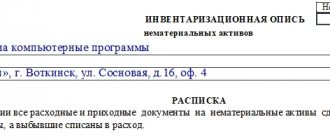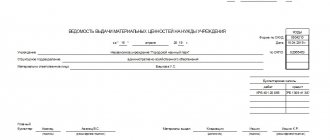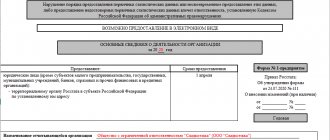Inventory inventory: types of forms
Inventory inventory forms were approved by the Decree of the State Statistics Committee of the Russian Federation “On approval of unified forms of primary accounting documentation for recording cash transactions, for recording inventory results” dated 08.18.1998 No. 88.
At the same time, for government bodies, local self-government, management bodies of state extra-budgetary funds, State (municipal) institutions developed special forms of inventory lists (matching statements). They were approved by order of the Ministry of Finance of Russia dated March 30, 2015 No. 52n. For example, inventory form 0504087 is used to reflect the results of an inventory of non-financial assets carried out in an institution.
The most commonly used types of inventory records are:
- inventory list of fixed assets (INV-1);
For information on the design features of INV-1, see the material “Unified Form No. INV-1 - Form and Sample” .
- inventory inventory of intangible assets (INV-1a);
- inventory inventory of inventory items (INV-3 form);
- cash inventory act (INV-15);
Features of filling out INV-15 are disclosed in the material “Unified Form No. INV-15 - Form and Sample” .
- act of inventory of receivables and payables (INV-17).
For information on the procedure for filling out INV-17, see the material “Unified Form No. INV-17 - Form and Sample” .
The procedure, nuances and timing of inventory are described in detail in the Tax Guide “Practical Guide to Annual Reporting” from ConsultantPlus. Study the material by getting trial access to the K+ system for free.
In this article, as an example, we will consider the procedure for filling out an inventory list for intangible assets and goods and materials.
Inventory card for accounting of fixed assets
An inventory card is a document that reflects information about all movements of a fixed asset. It is issued in the following situations:
- Any activity is carried out with the OS object (from the beginning of its registration);
- OS is moved within the organization, revalued, repaired, disposed of;
- The first entry in the card is made at the time of acceptance for registration or during introduction into use.
An inventory card for recording fixed assets allows you to solve many important problems, such as:
- Organizing information;
- Simplification of the analysis of OS information – for the company manager and other employees, as well as for inspection bodies;
- You can very quickly compile statistics about OS objects.
Necessary information to issue a card
An OS accounting card is created on the basis of an OS acceptance and transfer certificate. From the same document, some information about the purchased object is entered into it. Data from accompanying papers is also used.
A complete list of information required to correctly fill out the card is given below:
- Full name of the company;
- The name of a separate division, the OS of which is reflected in a particular case;
- Number and date of document generation;
- The object, as well as its main characteristics (date of construction, manufacturer, number and series);
- Codes for OKUD, OKOF and OKPO;
- Serial number, inventory number, depreciation group number, passport number;
- Date of acceptance for registration and date of deregistration;
- Account and subaccount;
- Analytical accounting code;
- The location where the OS object is located;
- Organization-manufacturer of the object;
- Information about the asset known at the time of its acceptance for accounting;
- Information about revaluation;
- Admission data;
- Information about changes in the original price;
- A short description and characteristics.
Procedure for filling out the card
The inventory card is filled out in the following order:
- Entering the necessary information into the card header - date of issue and card number in order.
- The accountant fills in the required details of the organization.
- The purpose of the structural unit is determined.
- The full name of the fixed asset accepted for accounting in the appropriate manner is indicated.
- Enter the number of the depreciation group to which the object belongs.
- The location of the OS object is determined.
- The first section is filled out - information about the object at the time of transfer is entered: production date, information about putting into use, service life, depreciation amount, residual value (only for objects that have already been in use).
- The second section is filled out - information about private investment and initial cost is recorded (this information is required for calculating depreciation).
- Section four is filled out - it indicates information about the acceptance of the object: details of the acceptance paper, the price of the object, as well as the full name and position of the responsible employee.
- Section seven is filled out - a brief description of the OS is written down.
- The third section is filled in only when a revaluation of an asset has occurred. The date of revaluation, conversion factor and replacement cost are indicated.
- The fifth section is filled out only if the original price of the property changes during modernization, reconstruction or liquidation.
- Section six includes information on the costs of repairing fixed assets.
After the card has been completely filled out, it is signed by the employee responsible for its storage and execution. In most cases, this employee is an accountant.
Card storage period
Inventory cards are primary reporting documentation. In this regard, standard rules apply to them. This means that after disposal of an object, they must be stored in the organization for at least five years. After this, the cards can be recycled.
Inventory of cards
An inventory of inventory cards is a mandatory procedure for organizations that must be carried out every few years. The main purpose of this is to register the IP.
This procedure will help ensure that all documents are safe and sound. Registration must be carried out in full accordance with the accounting budget accounts.
When disposing of an asset, the following information must be reflected:
- Date of operation – year, day and month;
- Serial number according to the transaction registration book.
Features of card design in budgetary organizations
There are nuances that are associated with accounting for property in budgetary institutions. To begin with, it is worth defining a list of situations when disposal of objects occurs:
- The donation occurs free of charge;
- The object became completely unusable;
- A shortage is identified - write-off is carried out at the expense of employees found guilty;
- Write-off of shortages due to natural disasters.
Upon disposal, the following documentation must be completed:
- Act on write-off of fixed assets (not drawn up for transport);
- An act of writing off an entire group of objects at once;
- Act on write-off of motor vehicles;
- The act of writing off soft and household equipment;
- The act of writing off library literature.
Similar articles
- Inventory card for accounting of fixed assets
- Inventory list of intangible assets (sample)
- Inventory card for accounting of fixed assets
- Inventory list of intangible assets (sample)
- We draw up an inventory list - forms and samples
The procedure for filling out an inventory list using the example of the INV-1a form (download)
The inventory inventory form in INV-1 form provides information about the company’s intangible assets.
IMPORTANT! During the inventory, you should make sure that the object is correctly classified as intangible assets.
As a rule, 2 copies of the inventory list are compiled. The header records information about the timing of the inspection, as well as about the documents justifying the start of its implementation. After this, a receipt is provided on the receipt and write-off of intangible assets by the responsible persons.
Information on objects is entered into the tabular part of the inventory list in accordance with accounting data and actual availability. In case of deviations of the fact from the accounting data, this is indicated in the inventory.
You can download an inventory list - an example and a sample of filling out INV-1a on our website:
Let's look at an example of filling out an inventory list using the INV-3 form.
Who fills it out and when?
Inventory can be carried out either mandatory or voluntary:
- This procedure must be carried out if the property will be rented out, as well as when purchasing or preparing for sale. When transforming a unitary or state enterprise, an inventory is also required. It is also necessary in case of personnel changes, fires, cases of theft, if the company is being liquidated or undergoing reorganization, as well as before submitting the annual report.
- On a voluntary basis , an inventory of inventory items is carried out in the organization on the basis of an order from the manager, which determines the dates for inspections, their number per year and a list of property to be reconciled.
The inventory is carried out by a special commission, which is created precisely for this purpose. Her powers are confirmed by an order from the head of the organization. The presence of a financially responsible person is required . The commission carries out recalculation, weighing and other necessary measurements of accountable values.
In the case where material assets are located in several places, the commission must carry out its work at all storage points.
During an inspection over several days, the room in which this process is taking place must be sealed while the commission leaves. Documents are not removed from these places during breaks in work, but remain in closed safes (cabinets).
When conducting an audit, in necessary cases, inventory can be shipped from the warehouse only by persons bearing financial responsibility, but certainly with a permit signed by the manager and chief accountant. Members of the commission are required to be present. Inventory items can also be delivered to storage locations during inventory counting. All inventories (both received and issued) are recorded in separate inventories.
Information on how inventory of goods is completed in the 1C program is presented in the following video:
How to correctly draw up an inventory order - read this article. What is an inventory card for accounting for a fixed asset - see here.
Sample of filling out an inventory list of inventory items
The inventory inventory of inventory items in the INV-3 form is also drawn up in 2 copies. Filling out the inventory can be done using computer technology or manually. On the 1st sheet in front of the table, financially responsible persons affix their signatures. Data in columns 1–9 of the inventory table is entered based on the information available to the taxpayer.
IMPORTANT! In column 9 “Passport number” the value is entered only if we are talking about precious metals.
Columns 10 and 11 of the inventory list reflect the actual availability of objects, and the values in columns 12 and 13 are entered according to accounting data. When damage to objects is detected, reports are drawn up, and any deviations found are included in the inventory. After filling out the table, the inventory is endorsed by the commission and responsible persons.
You can take an inventory of inventory items on our website:
Filling out the fields of the INV-3 form
The inventory header differs from an inventory order or resolution in that it indicates the type of activity of the enterprise (OKONH code). In some samples this field is left blank, but this practice is incorrect. But “Type of transaction” is not filled out quite reasonably if the company does not use a code system. It is also acceptable not to indicate the code of the structural unit.
It is important to note that there is no dash in place of the type of operation:
The next step is to move directly to compiling an inventory of inventory items. The document must be assigned a number and also be stamped with a completion date, which is often similar to the inventory completion date.
In our example, we are talking about accounting for inventory balances, but INV-3 can cover raw materials, materials, products, etc. They can either be owned by the enterprise or received for processing or storage.
Financially responsible persons must put signatures on both the first and last pages (see Page No. 4). This indicates that they are familiar with the accounting results.
Results
Monitoring the compliance of real information and information reflected in accounting data for current and non-current assets, as well as short-term and long-term liabilities, allows you to avoid errors in accounting and tax accounting.
The correct preparation of inventory records will help to perform this function. You can find more complete information on the topic in ConsultantPlus. Free trial access to the system for 2 days.








